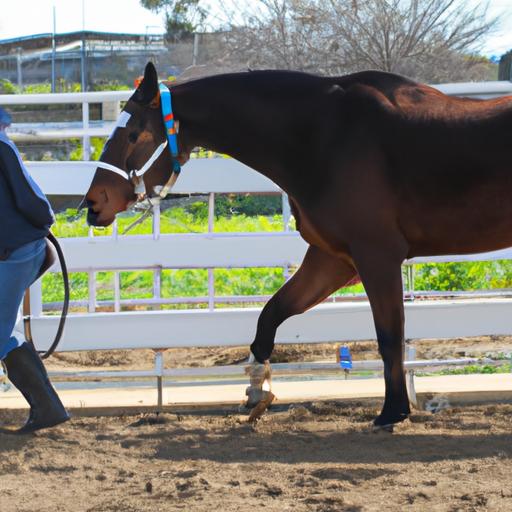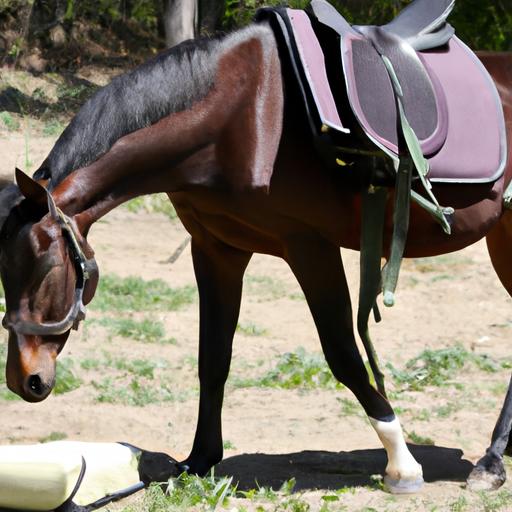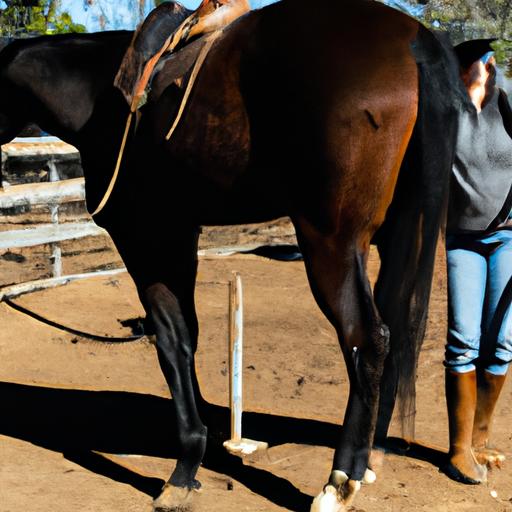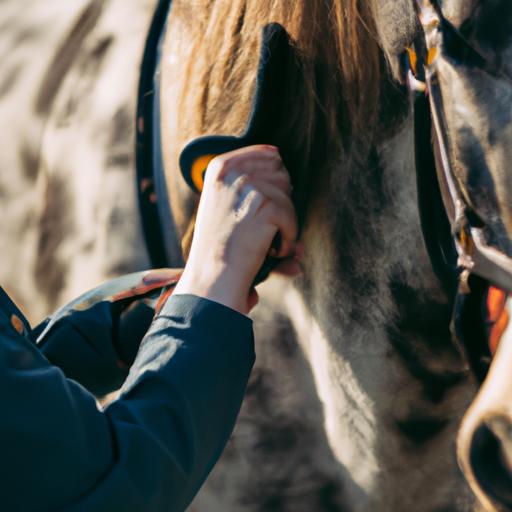Discover the crucial steps in training a rescue horse part 1. Learn how to build a lasting bond and understand the importance of rehabilitation.
Rescue horses often come with a past filled with trauma and neglect, making their journey towards trust and rehabilitation a unique challenge. In this first part of our series on training a rescue horse, we will explore the crucial steps involved in building a strong foundation based on understanding, trust, and connection. By delving into the importance of training a rescue horse and the benefits of establishing a bond, we aim to equip you with valuable insights for a successful partnership.
Understanding the Importance of Training a Rescue Horse

When we choose to train a rescue horse, we are not only transforming their lives but also giving them an opportunity for a fresh start. These incredible creatures possess immense potential, waiting to be unlocked through patient and compassionate training methods. By investing time and effort into their rehabilitation, we can help them overcome their past experiences and develop into confident, well-rounded individuals.
The Benefits of Establishing a Bond with a Rescue Horse

Building a bond with a rescue horse goes beyond the realm of training techniques; it forms the very foundation of a successful partnership. As we establish trust and create a safe environment, we pave the way for effective communication, mutual understanding, and respect. The bond we forge with our rescue horse opens doors to endless possibilities, enabling us to embark on a journey of growth and transformation together.
By fostering a deep connection with our rescue horse, we not only ensure their emotional well-being but also enhance their overall performance. A horse that trusts and respects its handler is more likely to respond positively to training, making the process smoother and more rewarding for both parties involved. As we invest time and energy into building this bond, we lay the groundwork for a harmonious and fulfilling partnership.
Join us in the next section as we delve into the crucial task of assessing a rescue horse’s background and needs. By understanding their history and identifying their specific requirements, we can tailor our training approach to cater to their unique circumstances. Together, let’s embark on this transformative journey of training and rehabilitation, one step at a time.
Stay tuned for Assessing the Rescue Horse’s Background and Needs.
Assessing the Rescue Horse’s Background and Needs

Evaluating the Horse’s History and Trauma
Before embarking on the training journey with a rescue horse, it is crucial to delve into their past and understand the experiences that have shaped them. By evaluating their history and any previous trauma they may have endured, we gain valuable insights into their behavior patterns and triggers. This understanding allows us to approach their training with empathy and tailor our methods to their specific needs.
Take the time to gather information about the rescue horse’s previous owners, living conditions, and any traumatic events they may have encountered. This can be done through conversations with previous caregivers or by studying any available documentation. Understanding their past will provide us with a roadmap for their emotional healing and guide us in developing trust and confidence.
Identifying the Horse’s Physical and Emotional Needs
Rescue horses often require specialized care due to their history of neglect or mistreatment. By identifying their physical and emotional needs, we can provide them with the support necessary for their well-being and progress in training.
Evaluate the horse’s physical condition, noting any signs of malnutrition, injuries, or health issues that may require attention. Collaborate with a veterinarian to develop a tailored feeding and healthcare plan that addresses their specific requirements.
Equally important is understanding the horse’s emotional needs. Some rescue horses may exhibit fear, anxiety, or trust issues as a result of their past experiences. By recognizing and acknowledging these emotional challenges, we can implement training methods that promote their emotional healing and growth.
Remember, each rescue horse is unique, and their needs may vary. Be patient and observant, allowing them the time and space required to adjust to their new environment. By providing a nurturing and supportive atmosphere, we lay the groundwork for a successful training journey.
In the upcoming section, we will delve into the critical task of building trust and establishing a connection with your rescue horse. Join us as we explore techniques to create a safe and comfortable environment that fosters a strong bond between horse and handler.
Stay tuned for Building Trust and Establishing a Connection.
Building Trust and Establishing a Connection
Creating a Safe Environment for the Horse
Building trust with a rescue horse begins with creating a safe and secure environment. Imagine yourself in the horse’s shoes – would you feel comfortable and at ease in the surroundings? By ensuring that their physical and emotional needs are met, we lay the foundation for trust to flourish.
1. Provide a Peaceful Sanctuary: Set up a designated space for your rescue horse that offers peace and tranquility. A well-maintained pasture or stall with ample space for movement allows the horse to feel safe and secure. Remove any potential hazards or sources of anxiety to create a peaceful sanctuary.
2. Consistent Care and Feeding: Regular feeding schedules and consistent care routines are vital for building trust. Horses thrive on predictability, and by providing them with a structured routine, you establish a sense of security. Ensure that feeding times, grooming sessions, and exercise routines are consistent to instill a feeling of reliability.
Developing a Consistent Routine for the Horse’s Care
Consistency plays a crucial role in building trust and establishing a connection with your rescue horse. By developing a consistent routine for their care, you create a sense of stability and reliability. This routine should encompass various aspects of their daily life, including feeding, grooming, exercise, and socialization.
1. Establish a Feeding Schedule: Horses are creatures of habit, and a consistent feeding schedule helps them feel secure. Determine the appropriate amount and type of feed for your horse, and divide it into regular meals throughout the day. Stick to these designated feeding times to establish a routine that your horse can rely on.
2. Regular Grooming Sessions: Grooming not only keeps your horse’s coat clean and healthy but also serves as a bonding activity. Set aside dedicated time each day for grooming sessions, where you can interact with your horse in a soothing and gentle manner. This regular contact helps build trust and connection over time.
3. Exercise and Socialization: Regular exercise is essential for your rescue horse’s physical and mental well-being. Create a consistent exercise routine that includes a mix of groundwork exercises, lunging, and free time for your horse to roam and socialize with other compatible horses. This routine allows them to develop mental stimulation, physical fitness, and positive social interactions.
By focusing on creating a safe environment and developing a consistent care routine, we establish the groundwork for trust and connection with our rescue horse. In the next section, we will explore the importance of basic groundwork and desensitization exercises, which are crucial steps in their training journey.
Stay tuned for Basic Groundwork and Desensitization Exercises.
Basic Groundwork and Desensitization Exercises
Introducing the Horse to Basic Groundwork Techniques
Before embarking on riding training, it is vital to lay a solid foundation of basic groundwork techniques with your rescue horse. These exercises not only establish clear communication and boundaries but also build trust and respect between you and your equine partner.
Start by teaching your horse to respond to simple commands such as “walk,” “halt,” and “back up.” Use consistent verbal cues combined with gentle physical prompts to guide them through each action. Reinforce positive behavior with praise and rewards, such as treats or gentle strokes.
Gradually progress to more complex maneuvers, such as lunging and long-lining. These exercises help your rescue horse develop balance, coordination, and focus. They also provide an opportunity for you to assess their responsiveness and address any potential behavioral issues in a controlled environment.
Desensitizing the Horse to Various Stimuli
Rescue horses often come with heightened sensitivity due to their past experiences. It is essential to gradually expose them to various stimuli to help them overcome fear and become desensitized. This process involves introducing them to different objects, sounds, and sensations in a controlled and positive manner.
Start by introducing your horse to common objects found in their everyday environment, such as plastic bags, umbrellas, or tarps. Allow them to approach and investigate these objects at their own pace while providing reassurance and encouragement.
Next, expose your horse to various sounds, such as clapping, rattling cans, or the noise of a whip cracking from a distance. Begin with low-intensity sounds and gradually increase the volume to ensure a gradual and comfortable transition.
Finally, incorporate desensitization exercises that involve touch and pressure. Gently expose your horse to different sensations, such as rubbing a soft brush, applying light pressure with your hands or a rope, or introducing them to different textures and surfaces.
Remember, patience is key during this process. Each horse is unique, and the time it takes to desensitize them may vary. By gradually introducing them to new experiences and providing a safe and positive environment, you can help your rescue horse overcome their fears and build confidence.
Stay tuned for Introducing the Horse to Tack and Equipment.
Introducing the Horse to Tack and Equipment
Gradually Introducing the Horse to Saddles, Bridles, and Other Equipment
Once you have established a solid foundation of trust and connection with your rescue horse, it’s time to introduce them to the world of tack and equipment. However, it’s crucial to approach this step with patience and sensitivity, as many rescue horses may have had negative experiences with such gear in the past.
Start by introducing the horse to the sight and presence of saddles, bridles, and other equipment. Allow them to investigate and familiarize themselves with these objects at their own pace. Remember, the key is to create a safe and positive association with the tack.
Next, gradually introduce the physical contact of the equipment. Gently touch the horse’s body with the saddle, allowing them to feel its weight and texture without causing any discomfort. Use positive reinforcement techniques such as treats or praise to reward the horse for their calm and accepting behavior.
Teaching the Horse to Accept and Respond to Tack
As the horse becomes more comfortable with the presence of tack, it’s time to teach them to accept and respond to it. Begin by placing the saddle lightly on their back, ensuring it is properly fitted and doesn’t cause any discomfort. Gradually increase the duration of the saddle’s presence, always observing the horse’s response and adjusting accordingly.
Once the horse is accustomed to the saddle, introduce the bridle. Start by allowing them to gently mouth the bit, getting them used to its presence in their mouth. Progressively introduce the other parts of the bridle, such as the headstall and reins, ensuring a gradual and positive transition.
Throughout this process, remember to be patient and understanding. Some rescue horses may take longer to adapt to tack than others, and that’s okay. By using positive reinforcement and taking small steps, you can help your horse develop a positive association with the equipment and build their confidence in accepting and responding to tack.
Continue the journey of training your rescue horse in Section 6, where we will delve into the beginning stages of basic riding training. Together, we will explore the essential steps involved in introducing mounting, dismounting, and establishing basic riding commands and cues.
Stay tuned for Beginning Basic Riding Training.


